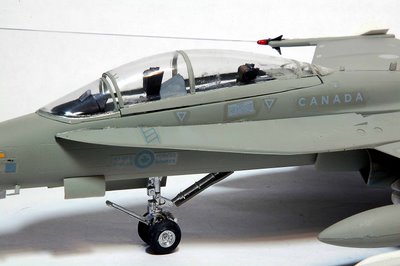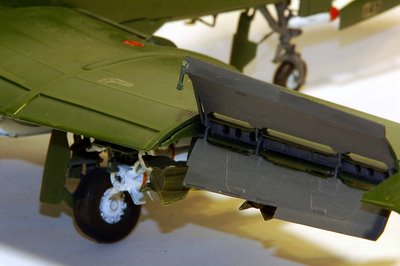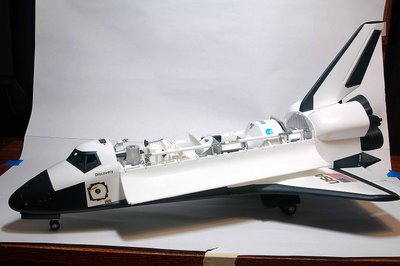Sunday, December 17, 2006
Revell Lockheed SR-71A 1/72 Scale
The SR-71 Blackbird holds the record for fastest and highest flying manned aircraft with air-breathing engines. The aircraft could fly faster than Mach 3 at more than 90,000 feet. It was designed and built at the Lockheed "Skunk Works" in the early 1960's to replace the U-2 spy planes. The mission of the aircraft was strategic reconnaissance and it carried an array of cameras and sensors in its weapons bay.
More information:
http://www.sr-71.org/blackbird/sr-71/
http://en.wikipedia.org/wiki/SR-71_Blackbird
http://www.aviationexplorer.com/sr-71_facts.htm
F-111E 1/48 Scale
Nicknamed 'Aardvark' because of its long, slightly upturned nose, the F-111 evolved in response to a joint services requirement in the 1960s for a long range interceptor (US Navy) and deep-strike interdictor (USAF). The F-111 was a multipurpose tactical fighter bomber capable of supersonic speeds. The aircraft was one of the more controversial aircraft ever to fly, yet it achieved one of the safest operational records of any aircraft in USAF history and became a highly effective all-weather interdiction aircraft.
The F-111 provided many firsts among weapons systems. It was the first production aircraft with variable swing wings that could be swept back or brought forward to increase efficiency. It also had the first terrain-following radar, allowing it to fly at night at high speeds and low altitudes, as well as the first crew escape module. The aircraft was produced in seven different variants with the first production aircraft delivery in October 1967 and the last delivery in September 1976. F-111's are no longer in the Air Force inventory but were a major part of the fighter force for many years.
More information:
http://www.globalsecurity.org/military/systems/aircraft/f-111-history.htm
http://www.georgespangenberg.com/vf2.htm
http://www.historycentral.com/aviation/fpostwar/F111.html
Revell F-14D Tomcal 1/48 Scale
The Grumman F-14 Tomcat is a supersonic, twin-engine, two-seat, variable geometry wing aircraft. During its active service in the United States Navy (1972-2006) the F-14 Tomcat was the Navy's primary air superiority fighter and tactical reconnaissance platform. It later performed precision bombing in close air support roles.[2]
It was developed after the collapse of the F-111B project, and was the first of the American teen-series fighters which were designed incorporating the experience of air combat in Vietnam against Migs.It entered service in 1972 with the Navy, replacing the F-4 Phantom II. It was later exported to the Imperial Iranian Air Force in 1976. It was retired from the U.S. Navy fleet on 22 September 2006, having been replaced by the F/A-18E/F Super Hornet.[3] As of 2006, only the Islamic Republic of Iran Air Force still flies the aircraft.
More information:
http://en.wikipedia.org/wiki/F14_Tomcat
http://www.aeroflight.co.uk/types/usa/grumman/f-14/F-14_Tomcat.htm
http://en.wikipedia.org/wiki/History_of_the_F-14_Tomcat
AMT ERTL Lockheed ES-3A Shadow 1/48 Scale
The ES-3A Shadow is carrier aviation's principal signals intelligence (SIGINT) reconnaissance aircraft. This electronic reconnaissance aircraft supports all facets of Navy, Marine Corps, and joint operations. As one of carrier aviation's newest additions, the ES-3A has already demonstrated tremendous reliability and safety, as well as a robust mission capability.
In addition to its ability to exploit enemy electronic emissions, the aircraft will be able to link its receivers to terminals on ships or in ground stations, providing surface operators the capability to exploit targets far beyond their radio horizon. This new capability is embodied in the Battle Group Passive Horizon Extension System (BGPHES), and is scheduled for a prototype deployment in 1997 with the USS John F. Kennedy (CV 67) battle group.
The ES-3A will also undergo significant mission upgrades through a sensor improvement program. This will provide complete connectivity with a number of tactical data links. Mission software improvements will, for the first time, link off-board sensors with on-board sensors, giving Shadow crews a total, integrated picture of the battlespace.
Model Reviews:
http://modelingmadness.com/reviews/mod/krausees3.htm
http://hsfeatures.com/es3asn_1.htm
More information:
http://navysite.de/planes/es3.htm
http://www.globalsecurity.org/intell/systems/es-3_shadow.htm
http://en.wikipedia.org/wiki/ES-3_Shadow
Revell F-15A Eagle 1/48 Scale
The F-15 Eagle is an all-weather, extremely maneuverable, tactical fighter designed to permit the Air Force to gain and maintain air superiority in aerial combat. Features The Eagle's air superiority is achieved through a mixture of unprecedented maneuverability and acceleration, range, weapons and avionics. It can penetrate enemy defense and outperform and outfight any current enemy aircraft.
The F-15 has electronic systems and weaponry to detect, acquire, track and attack enemy aircraft while operating in friendly or enemy-controlled airspace. The weapons and flight control systems are designed so one person can safely and effectively perform air-to-air combat. The F-15's superior maneuverability and acceleration are achieved through high engine thrust-to-weight ratio and low wing loading. Low wing-loading (the ratio of aircraft weight to its wing area) is a vital factor in maneuverability and, combined with the high thrust-to-weight ratio, enables the aircraft to turn tightly without losing airspeed.
Model review:
http://www.fortunecity.com/meltingpot/portland/971/Reviews/70s/f-15c_48.htm
More information:
http://www.aviationexplorer.com/f-15_facts.htm
http://www.globalsecurity.org/military/systems/aircraft/f-15-history.htm
http://www.geocities.com/capecanaveral/hangar/8765/f-15.html
http://www.boeing.com/history/mdc/eagle.htm
Testor McDonnell Douglar F/A-18 1/48 Scale
The F/A-18 "Hornet" is a supersonic, single seat (A and C models) or tandem seat (B and D models), twin engine, all weather, night, combined fighter and attack aircraft and can be refueled in flight. The F/A-18 multi-mission aircraft can operate from either aircraft carriers or land bases. The F/A-18 fills a variety of roles: air superiority, fighter escort, suppression of enemy air defenses, reconnaissance, forward air control, close and deep air support, and day and night strike missions. The F/A-18 Hornet replaced the F-4 Phantom II fighter and A-7 Corsair II light attack jet, and also replaced the A-6 Intruder as these aircraft were retired during the 1990s.
The combat-proven F/A-18 Hornet is the first tactical aircraft designed from its inception to carry out both air-to-air and air-to-ground missions. The F/A-18, (models A, B, C and D), can deliver conventional air-to-air, air-to-ground decoy expendables, and can carry airborne control pods for various missions. The combination of excellent thrust-to-weight ratio, and maneuverability an unmatched combat capability.
More information:
http://www.globalsecurity.org/military/systems/aircraft/f-18.htm
http://www.globalsecurity.org/military/systems/aircraft/f-18-history.htm
http://www.aviationexplorer.com/f-18_facts.htm
http://en.wikipedia.org/wiki/F/A-18_Hornet
A-10 Warthog 1/48 Scale
The A-10 and OA-10 Thunderbolt IIs are the first Air Force aircraft specially designed for close air support of ground forces. They are simple, effective and survivable twin-engine jet aircraft that can be used against all ground targets, including tanks and other armored vehicles.
The primary mission of the A-10 is to provide day and night close air combat support for friendly land forces and to act as forward air controller (FAC) to coordinate and direct friendly air forces in support of land forces. The A-10 has a secondary mission of supporting search and rescue and Special Forces operations. It also possesses a limited capability to perform certain types of interdiction. All of these missions may take place in a high or low threat environment.
The A/OA-10 aircraft was specifically developed as a close air support aircraft with reliability and maintainability as major design considerations. The Air Force requirements documents emphasized payload, low altitude flying capability, range and loiter capability, low speed maneuverability and weapons delivery accuracy. The A-10 is slow enough to be an observation plane. This greatly increases the A-10's effectiveness at protecting ground troop,
More information:
http://www.globalsecurity.org/military/systems/aircraft/a-10.htm
http://www.globalsecurity.org/military/systems/aircraft/a-10-history.htm
http://www.aviationexplorer.com/a-10_facts.htm
Monogram F-20 Tigershark 1/48 Scale
In 1975, Northrop began development on the F-20 Tigershark, a fighter plane designed to be reliable, easy to fly and inexpensive to maintain. Northrop didn't accept any funds from the government to develop the plane, so the company didn't have to consult the Air Force or any other government agency to make design decisions. As a result, the development process went fairly quickly. Northrop built three planes to take around the world to fly in demonstrations for potential customers.
According to many pilots, the Tigershark was an excellent plane. It could be ready for combat just one minute after takeoff, and it could climb 53,800 feet per minute. Northrop planned to sell the plane to foreign countries for use in their militaries. However, as a result of many political changes as well as competition from other aircraft such as the F-16, the market for the plane never developed.
Model reviews:
http://modelingmadness.com/reviews/mod/previews/leef20preview.htm
http://www.fortunecity.com/meltingpot/portland/971/Reviews/modern/f-20_48.htm
Other information:
http://en.wikipedia.org/wiki/F-20_Tigershark
http://www.f20a.com/
http://www.answers.com/topic/f-20-tigershark
Monogram NASA Space Shuttle 1/72 Scale
Discovery, the third orbiter to become operational at Kennedy Space Center, was named after one of two ships that were used by the British explorer James Cook in the 1770s during voyages in the South Pacific that led to the discovery of the Hawaiian Islands. Another of his ships was the Endeavour, the namesake of NASA's newest orbiter.
Cook also used Discovery to explore the coasts of southern Alaska and northwestern Canada. During the American Revolutionary War, Benjamin Franklin made a safe conduct request for the British vessel because of the scientific importance of its research.
Other famous ships have carried the name Discovery, including one used by Henry Hudson to explore Hudson Bay in Canada as well as search for what was hoped to be the northwest passage from the Atlantic to the Pacific in 1610 and 1611. Another, based on whaling ship design, was used by the British Royal Geographical Society for an expedition to the North Pole in 1875. This organization then built another Discovery in 1901 to conduct its Antartic expedition that concluded in 1904. This ship still exists and is being preserved by the Society.
In the day-to-day world of Shuttle operations and processing, Space Shuttle orbiters go by a more prosaic designation. Discovery is commonly refered to as OV-103, for Orbiter Vehicle-103. Empty Weight was 151,419 lbs at rollout and 171,000 lbs with main engines installed.
More information:
http://en.wikipedia.org/wiki/Space_Shuttle
http://history.nasa.gov/shuttlehistory.html





















































